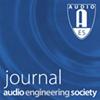Auralization of Measured Room Transitions in Virtual Reality
IF 1.6
4区 工程技术
Q3 ACOUSTICS
引用次数: 1
Abstract
To auralise a room’s acoustics in six degrees-of-freedom (6DoF) virtual reality (VR), a dense set of spatial room impulse response (SRIR) measurements is required, so interpolating between a sparse set is desirable. This paper studies the auralisation of room transitions by proposing a baseline interpolation method for higher-order Ambisonic SRIRs and evaluating it in VR. The presented method is simple yet applicable to coupled rooms and room transitions. It is based on linear interpolation with RMS compensation, though direct sound, early reflec-tions and late reverberation are processed separately, whereby the input direct sounds are first steered to the relative direction-of-arrival before summation and interpolated early reflections are directionally equalised. The proposed method is first evaluated numerically, which demonstrates its improvements over a basic linear interpolation. A listening test is then conducted in 6DoF VR, to assess the density of SRIR measurements needed in order to plausibly auralise a room transition using the presented interpolation method. The results suggest that, given the tested scenario, a 50 cm to 1 m inter-measurement distance can be perceptually sufficient.虚拟现实中测量房间过渡的听觉化
为了在六自由度(6DoF)虚拟现实(VR)中实现房间声学的听觉化,需要一组密集的空间房间脉冲响应(SRIR)测量值,因此需要在稀疏集之间进行插值。本文通过提出一种高阶Ambisonic SRIR的基线插值方法并在VR中对其进行评估,研究了房间转换的听觉化。所提出的方法简单,但适用于耦合房间和房间转换。它基于RMS补偿的线性插值,尽管直接声音、早期反射和后期混响是单独处理的,因此输入的直接声音在求和和和插值的早期反射定向均衡之前首先被引导到相对到达方向。首次对所提出的方法进行了数值评估,证明了其对基本线性插值的改进。然后在6DoF VR中进行听力测试,以评估所需的SRIR测量密度,以便使用所提出的插值方法合理地听觉化房间转换。结果表明,在测试场景中,50厘米到1米的相互测量距离在感知上是足够的。
本文章由计算机程序翻译,如有差异,请以英文原文为准。
求助全文
约1分钟内获得全文
求助全文
来源期刊

Journal of the Audio Engineering Society
工程技术-工程:综合
CiteScore
3.50
自引率
14.30%
发文量
53
审稿时长
1 months
期刊介绍:
The Journal of the Audio Engineering Society — the official publication of the AES — is the only peer-reviewed journal devoted exclusively to audio technology. Published 10 times each year, it is available to all AES members and subscribers.
The Journal contains state-of-the-art technical papers and engineering reports; feature articles covering timely topics; pre and post reports of AES conventions and other society activities; news from AES sections around the world; Standards and Education Committee work; membership news, patents, new products, and newsworthy developments in the field of audio.
 求助内容:
求助内容: 应助结果提醒方式:
应助结果提醒方式:


